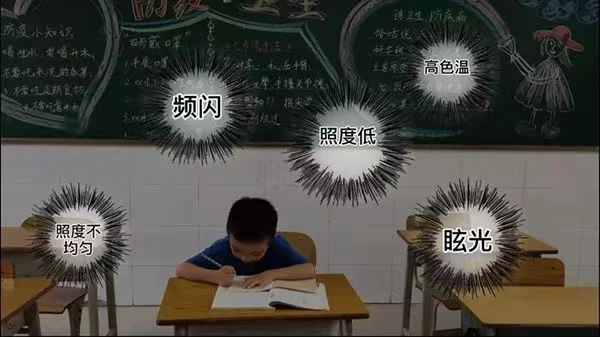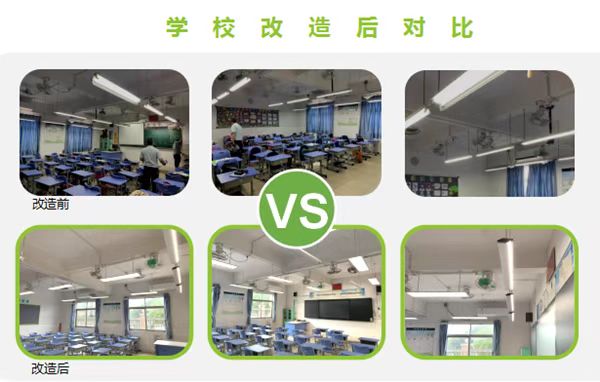
At present, the myopia rate of primary and secondary school students remains high. More and more people advocate to pay attention to the improvement of students' eyesight and the healthy lighting of the classroom, especially the parents of students pay special attention to it. The education industry has also issued relevant standards, such as the hygienic standards for lighting and lighting in primary and secondary school classrooms, the work plan for myopia prevention and control of primary and secondary school students, and the hygienic standards for lighting and lighting in primary and secondary school classrooms. What are the standards of health education lighting? There are six main standards for building healthy campus education lighting: excellent illumination, no glare, high color rendering index, no light stroboscopic hazard, moderate color temperature, and no blue light hazard.

1、 Excellent illumination
The Hygienic Standard for Daylighting and Lighting in Primary and Secondary School Classrooms points out that all classrooms should be equipped with artificial lighting, and the maintained average illumination value on the classroom desk should not be less than 300lx, and its illumination uniformity should not be less than 0.7; The blackboard of the classroom shall be equipped with local lighting, with the average illumination value maintained not less than 500lx and the illumination uniformity not less than 0.8. At present, the lighting lamps used in most classrooms are still fluorescent lamps. The average illuminance of the desk and blackboard is less than 200lx, and the blackboard is not specially equipped with lighting. When studying in the evening, the lack of lighting is very obvious, which easily leads to students too close to the desk to study. When reading the text on the blackboard, their eyes will automatically narrow, especially the students in the back row. This will cause eye fatigue and myopia.
In addition to avoiding being too dark and too bright, the educational lighting in the campus classroom also needs to control the illumination uniformity. Some schools do not plan to install lamps and lanterns directly and evenly. The installation method is inflexible, the debugging is difficult, and the fans, beams, and air outlets are not avoided. The light is not fully utilized.
2、 No glare
The Hygienic Standard for Lighting and Lighting in Primary and Secondary School Classrooms points out that the uniform glare value (URG) of classrooms should not be greater than 19. Based on the research of the cooperative project with the Education Equipment Research and Development Center of the Ministry of Education, whether it is a remote rural school or a key school in a first-tier or second-tier city, most of the fluorescent lamps and ordinary LED lamps used for classroom lighting have serious glare problems, which can easily lead to myopia, distract students' attention and affect learning efficiency. The data shows that the glare value of traditional T8 bracket fluorescent lamp and LED ordinary lamp without glare treatment is greater than 20, causing dazzling. Studying in this environment for a long time will cause students to feel dizzy.
3、 High color rendering index
The Hygienic Standard for Daylighting and Lighting in Primary and Secondary School Classrooms points out that the color rendering index of classroom lighting sources should not be less than 80. The data shows that the color rendering index of traditional T8 bracket fluorescent lamps and LED ordinary lamps without glare treatment is about 70, less than 80, and the color rendering index is less than 80, which will distort the picture you see.
4、 Matte strobe
Harmful stroboscopic has the most obvious impact on vision, which can easily distract students' attention and reduce learning efficiency. The stroboscopic phenomenon of traditional T8 fluorescent lamps is particularly serious when the starting and voltage are unstable, while when the current is stable, the light stroboscopic (fluctuation depth) is also greater than 40%, and the light stroboscopic of ordinary LED lamps is also greater than 20%. Learning in this environment for a long time is also easy to cause visual fatigue. The strobe of professional LED education lighting is less than or equal to 3.2%, far lower than the former two.
5、 Moderate color and temperature
The Hygienic Standard for Daylighting and Lighting in Primary and Secondary School Classrooms points out that the light source with color temperature of 3300K-5500K should be used in the classroom. At present, the color temperature of most professional LED educational lighting fixtures is 5000K, belonging to warm white light. However, many schools use traditional T8 fluorescent lamps and ordinary LED lamps. Their color temperature is more than 6500K, belonging to cold white light.
6、 No blue light
The word "harm" is familiar to everyone. The most commonly used word in optical stores is "anti-blue light". If ordinary LED lamps are not treated with anti-blue light, they are harmful. Professional education lighting LED lamps have been treated with professional treatment, reaching the exemption level, and no blue light hazard.

The educational lighting that meets these six points will be more realistic, not dazzling, and brighter than before: the eyes are very comfortable, with low fatigue, and will not be tired of learning because of eye fatigue, reducing the rate of myopia; The brightness of the blackboard is more uniform, and the eyes are more comfortable: intelligent control, more convenient for class.
Copyright © 2018 FOSHAN SHUNDE HUADA ELECTRICAL MANUFACTURE COMPANY LIMITED | All Rights Reserved Design by gdhuada.com